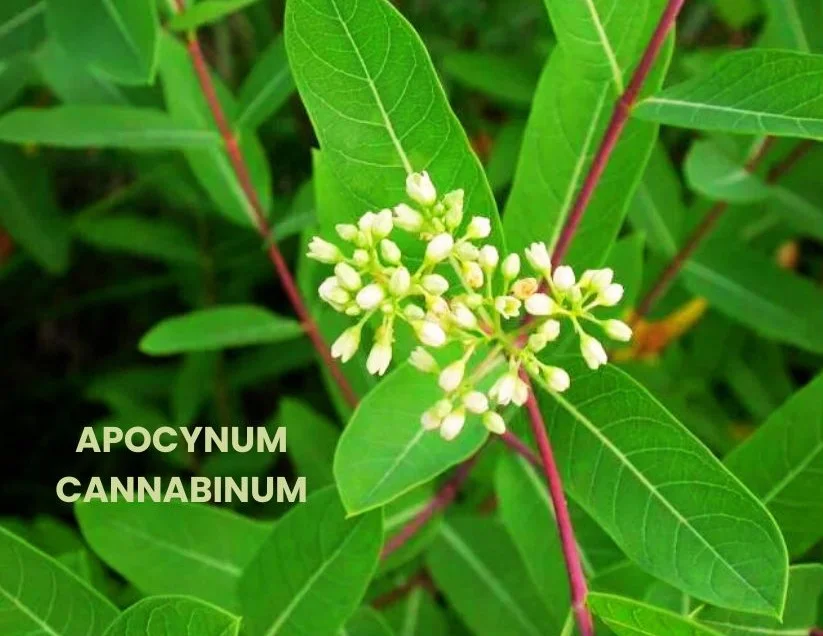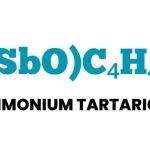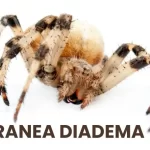Apocynum is renowned for its efficacy in treating various conditions such as dropsy, hydrocephalus, and ascites, placing it on par with the importance of Apis mellifica in homeopathic therapeutics.
PROVER – FREITAG

Table of Contents
ToggleSOURCE INFORMATION
- Kingdom: Plantae
- Phylum: Angiosperms
- Class: Eudicots
- Order: Gentianales
- Family: Apocynaceae
- Genus: Apocynum
- Species: cannabinum
Geographical Origin: Indian Hemp, scientifically known as Apocynum cannabinum, is native to North America.
It is commonly found in various regions of the United States and Canada, growing in moist habitats such as riverbanks, meadows, and wetlands.
Ethnobotanical Significance: The indigenous people of North America may have used different parts of Apocynum cannabinum, such as the roots and leaves, to prepare remedies for conditions like heart problems, edema, and as a diuretic.
Botanical Characteristics: Indian Hemp is a perennial herbaceous plant with opposite leaves and clusters of small, greenish-white flowers.
It belongs to the dogbane family (Apocynaceae) and is not related to true hemp (Cannabis sativa).
CLINICAL INDICATIONS
Apocynum is indicated in cases of ascites, amenorrhea (absence of menstruation), cough, dropsies (edematous conditions), heart affection, hydrocephalus (accumulation of fluid in the brain), metrorrhagia (uterine bleeding outside of menstruation), urinary affection, and vomiting.
SPHERES OF ACTION & PATHOGENESIS
- Urinary Organs: Apocynum exerts its influence on the urinary organs, inducing diuresis and facilitating the removal of dropsical effusions (accumulation of fluid in body cavities).
- Heart: It depresses cardiac function, affecting the heart, and may lead to relaxation of the sphincters.
- Digestive Tract: Apocynum’s action extends to the digestive tract, where it can produce intense gastric disturbances.
- Uterus: Additionally, Apocynum influences the uterus, making it useful in cases of metrorrhagia and amenorrhea.
CHIEF GUIDING SYMPTOMS
- Diminished Excretions
- Excretions, especially urine and sweat, are reduced.
- Dropsy with Thirst
- Dropsy accompanied by intense thirst (contrasted with Apis Mellifica, which presents dropsy without thirst).
- Disagreement with water, causing pain or leading to vomiting.
- Associated with heart, liver, and kidney diseases.
- Hydrocephalus
- Hydrocephalus with open sutures.
- Symptoms include stupor, loss of sight in one eye, constant and involuntary motion of one arm and one leg.
- Projected forehead.
- Amenorrhea in Young Girls
- Absence of menstruation in young girls.
- Bloating or dropsical extension of the abdomen and extremities.
- Metrorrhagia
- Uterine bleeding with continued or paroxysmal flow.
- Fluid or clotted blood.
- Accompanied by nausea, vomiting, palpitation, quick and feeble pulse.
- Vital depression, fainting upon rising from the pillow.
- Cough During Pregnancy
- Cough, either short and dry or deep and loose, during pregnancy.
- May be compared with Conium in this regard.
- Ailments From Various Causes
- Dropsy occurring after typhus, typhoid, scarlatina, cirrhosis, or abuse of quinine and alcohol.
Comparisons with Other Remedies
- Acetic Acid: Prominent in dropsy associated with diabetes and gastrointestinal diseases. Profound anaemia with waxy pallor, dropsy with great thirst and debility, sour belching, waterbrash, and diarrhoea. Restlessness lying on the back.
- Apis Mellifica: Oedema of hands and feet, anasarca, ascites. Dropsy without thirst. Characteristic bag-like puffy swelling under the eyes. Urine is frequent, painful, and scanty.
- Arsenicum Album (Ars. Alb.): Anasarca with pale, waxy, earth-coloured skin. Dropsy with burning thirst without a specific desire to drink. Intolerance to cold water due to the stomach’s inability to assimilate it. Great thirst for cold water, drinking often but in small quantities. Patient sleeps better on their back.
PARTICULARS
Nose
- Long-continued sneezing.
- Snuffles in children.
- Chronic nasal catarrh with a tendency to acute stuffiness and dull, sluggish memory.
- Easily prone to taking cold, congested, and blocked nostrils.
Stomach
- Nausea with drowsiness.
- Thirst on walking.
- Excessive vomiting; immediate ejection of food or water.
- Dull, heavy, sick feeling.
- Oppression in epigastrium and chest, hindering breathing.
- Sensation of sinking in the stomach.
- Bloating of the abdomen.
- Ascites.
Stool
- Watery, flatulent stool with soreness in the anus; aggravated after eating.
- Feeling as if the sphincter were open, and stools ran out.
Urine
- Bladder distended.
- Turbid, hot urine with thick mucus and burning in the urethra after urinating.
- Little expulsive power.
- Dribbling.
- Strangury.
- Renal dropsy.
Female
- Amenorrhea with bloating.
- Metrorrhagia with nausea and fainting; vital depression.
- Hæmorrhage at the change of life, with blood expelled in large clots.
Respiratory
- Short, dry cough.
- Short and unsatisfactory respiration.
- Sighing.
- Oppression around the epigastrium and chest.
Heart
- Tricuspid regurgitation; rapid and feeble, irregular cardiac action.
- Low arterial tension.
- Pulsating jugular veins.
- General cyanosis and dropsy.
Sleep
- Great restlessness and little sleep.
MODALITIES
- Worse: Cold weather, cold drinks, uncovering.
RELATIONSHIPS
- Cymarin: The active principle of Apocynum, it lowers the pulse rate and increases blood pressure.
- Strophanthus: Indicated for extreme cardiac depression with intense gastric disturbance and dropsy.
- Aralia Hispida (Wild Elder): A valuable diuretic, useful in dropsy of the cavities resulting from hepatic or renal disease with constipation. It addresses urinary disorders, especially those associated with dropsy. Recommended doses are five to thirty drops in sweetened cream of tartar solution.
- Apis, Arsenic, Digitalis, Helleborus: Remedies that share relationships with Apocynum in various aspects.
DOSE
- Tincture: Ten drops three times daily.
- Acute Alcoholism: 1 dram of decoction in 4 oz. water.
Frequently Asked Questions (FAQs)
What conditions does Apocynum Cannabinum address?
- Apocynum is renowned for its efficacy in treating dropsy, hydrocephalus, ascites, cough, heart affection, and urinary troubles.
- It is indicated in conditions such as amenorrhea, metrorrhagia, and vomiting.
Where is Indian Hemp (Apocynum Cannabinum) commonly found?
- Indian Hemp is native to North America and is commonly found in various regions of the United States and Canada.
- It typically grows in moist habitats like riverbanks, meadows, and wetlands.
What is the ethnobotanical significance of Apocynum Cannabinum?
- Indigenous people of North America may have used different parts of Apocynum Cannabinum, such as the roots and leaves, for remedies related to heart problems, edema, and as a diuretic.
How does Apocynum influence the body’s systems?
- Apocynum acts on urinary organs, inducing diuresis and removing dropsical effusions.
- It also depresses the heart, kidneys, and intestines, relaxing sphincters.
- Additionally, it produces intense gastric disturbances.
What are the key guiding symptoms of Apocynum Cannabinum?
- Diminished excretions, dropsy with thirst, hydrocephalus with open sutures, amenorrhea in young girls, metrorrhagia, cough during pregnancy, and ailments from various causes are key guiding symptoms.
How does Apocynum compare with other remedies?
- Apocynum can be compared with Acetic Acid, Apis Mellifica, and Arsenicum Album in dropsical conditions.
- It shares similarities with Acetic Acid in diabetes-associated dropsy, with Apis Mellifica in edema symptoms, and with Arsenicum Album in burning thirst and intolerance to cold water.
What are the modalities for Apocynum Cannabinum?
- Apocynum is worse in cold weather, with cold drinks, and when uncovered.
Are there specific relationships with other remedies?
- Apocynum shares relationships with Cymarin, Strophanthus, Aralia Hispida, Apis, Arsenic, Digitalis, and Helleborus in various aspects of homeopathic treatment.
What is the recommended dose of Apocynum Cannabinum?
- The suggested dose is ten drops of the tincture three times daily.
- For acute alcoholism, a decoction of 1 dram in 4 oz. water is recommended.













Leave a Reply